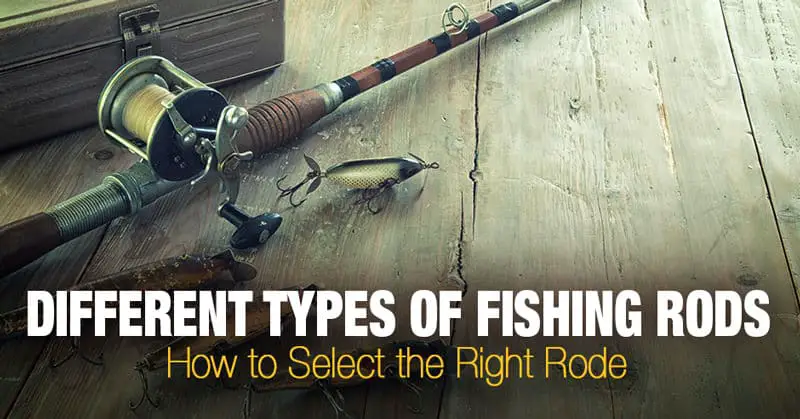If you looking to understand different types of fishing rods, you’ve come to the right place.

Having the best possible rod equipment is as crucial in fishing as it is in any sport. The primary things to consider while picking a rod are the place you’ll be fishing (lakes, waterways, streams, and so forth.), the sort of fish you’re after, and the kind of bait you’ll be using.
The distinction in rods comes down to length, weight (a measure of the rod‘s quality), and activity (how far it will twist before it’s prepared to spring back).
Table of Contents
Different Types of Fishing Rods
1. Casting Fishing Rods
Casting rods, sometimes called spin cast rods, hold a casting reel mounted over the handle. Casting rods are the least demanding kind of rod to use. It has a straightforward push-catch line discharge for casting and an encased “nosecone” where the line leaves the reel. They are also the cheapest kind of fishing rod. So this is a great decision for first-time fishers.
Casting rods are reasonable for most kinds of lakes and waterways. They are more effective than spinning rods because they can use heavier line and handle heavier cover (weeds, rocks, and so forth).
2. Spinning Fishing Rods
The reel hangs underneath the rod opposite the top, unlike the casting rod, with a spinning rod. The main advantage is that they enable you to hold the rod in your dominant hand, which builds control.
Having the reel’s weight hang beneath the rod opens for more comfortable fishing over a longer time. Spinning rods are superior to casting rods for accuracy and comfortability. They are generally utilized for sport fishing species, including bass, trout, pike, and walleye. They also usually come in the most variety of sizes and weights, as they are one of the more popular rod choices in fishing.
3. Ultralight Fishing Rods
Ultralight rods can be more challenging to land a fish. They are usually shorter in length, light built, and have lighter lines. They are mostly used for smaller fish, such as trout, smallmouth, and panfish. The light lines and rod are ideal for small streams and water systems where these fish call home. Most bait used with these rods are spinners, wet flies, tubes, and plastic worms.
These rods are great for anglers looking to shave weight and are up for a challenge.
4. Fly Fishing Rods
A fly rod is intended for fly fishing. It includes casting a lightweight draw, known as a “fake fly,” attached to a weighted line. The bait is masked with brilliantly shaded plumes, hide, hair, and different materials to pull in the fish while the overwhelming line sinks out of site.
Fly rods can be used to catch numerous sorts of fish, including trout, salmon, carp, pike, bass, and even marlin and sharks. The size of the rod relies upon the size of fish you are hoping to get. The bigger the fish, the heavier the rod required. It is important to pick the right size for the job, as fly rods are very flexible and are the most important to match your choice of fish species.
4. Surf Fishing Rods
Surf rods are commonly used as a part of fishing in the sea from the shoreline, rocks, or other parts of the shoreline. They look like larger spinning rods but have long hold handles for two-handed casting. Surf rods are really long, so you can cast past the breaking surf where fish have a tendency to gather. They are very strong and able to cast heavy bait or lure into the water.
These rods can tend to be very big and heavy and can take some practice to cast correctly.
5. Telescopic Fishing Rods
Telescopic angling rods are developed to either crumple down to a short length or open up into a more extended rod. These are useful for people short on space or to keep as a backup in case one of your other rods breaks. Telescopic rods come in a variety of sizes, and you can choose a length depending on the size you want and the fish you expect to catch.
Telescopic fishing rods are available in both spinning and casting models and are built of lightweight materials that make them easy to handle. Most telescopic fishing rods extend to a length of 9 or 10 feet, and they collapse down to just 27 or 28 inches in length, making them ideal for traveling.
Choosing the Right Material for Fishing Rod
Fishing rods can be created from many different materials. The materials influence the rod’s activity and should match your ability level and angling mode.
There are three fundamental types, fiberglass rods, graphite rods, and bamboo rods.
Fiberglass
Fiberglass rods are made for beginners and need little support with average weight and power. You may be fishing for heavy fish and need something strong, which is where this shine.
Graphite
Graphite rods are a favorite of advanced anglers because of their high quality and lightweight. They handle most situations well and give a lot more power in tough fish battles.
Bamboo
The last is bamboo, which produces smooth, fluid backcasts. These are more of a specialty rod for unique situations. No matter what material you choose, many different types of rods are made.
Types of Fishing Rods | Final Thoughts
Having the best possible equipment is crucial in fishing, as it is in any sport. With a wide variety of lure choices and techniques, rod makers have created rods to cast particular baits deeper and more accurately. They’ve also adjusted these abilities with different factors to give the fisherman advantages over a hooked fish.
The right rod for a given situation enables fishermen to cast draws precisely, work baits appropriately, get more strikes, and set the baits to land a fish. With so many choices, hopefully, you can now choose the rod that will best suit you!
